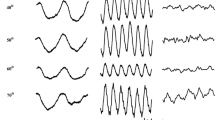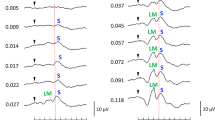Abstract
Purpose
To evaluate rod-isolated, cone-isolated, and combined rod and cone flicker electroretinograms (ERGs) as a possible means to identify electrophysiological abnormalities in carriers of X-linked retinoschisis (XLRS).
Methods
Full-field ERGs were recorded from six carriers of XLRS (aged 34–66 years) and eight normally sighted subjects (aged 27–59 years) under rod-isolated (ERGR), cone-isolated (ERGC), and combined rod and cone (ERGR+C) conditions. ERGs were obtained using a four-primary LED-based ganzfeld photostimulator and standard recording techniques. The four primaries were modulated sinusoidally in phase to achieve combined rod and cone activation (ERGR+C) or in different phases to achieve ERGR and ERGC by means of triple silent substitution. After 30 min of dark adaptation, 8- and 15-Hz ERGR, ERGC, and ERGR+C responses were obtained at a mean luminance level of 24 scot. cd/m2. Standard ISCEV ERGs were also obtained from each subject.
Results
The ISCEV and 15-Hz flicker ERGs were generally within the normal range for the carriers. The 8-Hz ERGR, ERGC, and ERGR+C amplitudes were also generally normal. In contrast, the carriers had ERGR, ERGC, and ERGR+C timing abnormalities, with phase advances beyond the range of normal for the ERGR (four carriers), ERGC (four carriers), and ERGR+C (three carriers). Only one carrier had normal 8-Hz responses under all conditions.
Conclusions
The 8-Hz ERG timing abnormalities in five of six carriers indicate that retinal function is not necessarily normal in carriers of XLRS. The 8-Hz flicker ERG may be useful for studying retinal function in these individuals.



Similar content being viewed by others
References
Sauer CG, Gehrig A, Warneke-Wittstock R, Marquardt A, Ewing CC, Gibson A, Lorenz B, Jurklies B, Weber BH (1997) Positional cloning of the gene associated with X-linked juvenile retinoschisis. Nat Genet 17(2):164–170
Wang T, Zhou A, Waters CT, O’Connor E, Read RJ, Trump D (2006) Molecular pathology of x linked retinoschisis: mutations interfere with retinoschisin secretion and oligomerisation. Br J Ophthalmol 90(1):81–86
Deutman AF (1971) The hereditary dystrophies of the posterior pole of the eye. Van Gorcum, Assen
George ND, Yates JR, Moore AT (1995) X linked retinoschisis. Br J Ophthalmol 79(7):697–702
Roesch MT, Ewing CC, Gibson AE, Weber BH (1998) The natural history of X-linked retinoschisis. Can J Ophthalmol 33(3):149–158
Sieving PA, MacDonald IM, Chan S (1993) X-linked juvenile retinoschisis. In: Pagon RA, Adam MP, Ardinger HH et al (eds) Genereviews(r). GeneReviews, Seattle
Peachey NS, Fishman GA, Derlacki DJ, Brigell MG (1987) Psychophysical and electroretinographic findings in X-linked juvenile retinoschisis. Arch Ophthalmol 105(4):513–516
Alexander KR, Fishman GA, Grover S (2000) Temporal frequency deficits in the electroretinogram of the cone system in X-linked retinoschisis. Vis Res 40(20):2861–2868
Kellner U, Brummer S, Foerster MH, Wessing A (1990) X-linked congenital retinoschisis. Graefes Arch Clin Exp Ophthalmol 228(5):432–437
Kellner U, Foerster MH (1993) Cone dystrophies with negative photopic electroretinogram. Br J Ophthalmol 77(7):404–409
Falsini B, Iarossi G, Porciatti V, Merendino E, Fadda A, Cermola S, Buzzonetti L (1994) Postreceptoral contribution to macular dysfunction in retinitis pigmentosa. Invest Ophthalmol Vis Sci 35(13):4282–4290
Alexander KR, Barnes CS, Fishman GA (2001) Origin of deficits in the flicker electroretinogram of the cone system in X-linked retinoschisis as derived from response nonlinearities. J Opt Soc Am A Opt Image Sci Vis 18(4):747–754
Murayama K, Kuo CY, Sieving PA (1991) Abnormal threshold erg response in X-linked juvenile retinoschisis—evidence for a proximal retinal origin of the human str. Clin Vis Sci 6(4):317–322
Wu G, Cotlier E, Brodie S (1985) A carrier state of X-linked juvenile retinoschisis. Ophthalmic Paediatr Genet 5(1–2):13–17
Kim LS, Seiple W, Fishman GA, Szlyk JP (2007) Multifocal erg findings in carriers of X-linked retinoschisis. Doc Ophthalmol 114(1):21–26
Arden GB, Gorin MB, Polkinghorne PJ, Jay M, Bird AC (1988) Detection of the carrier state of x-linked retinoschisis. Am J Ophthalmol 105(6):590–595
Jay B (1985) X-linked retinal disorders and the lyon hypothesis. Trans Ophthalmol Soc U K 104(Pt 8):836–844
Krill AE (1969) X-chromosomal-linked diseases affecting the eye: Status of the heterozygote female. Trans Am Ophthalmol Soc 67:535–608
Lyon MF (1962) Sex chromatin and gene action in the mammalian X-chromosome. Am J Hum Genet 14:135–148
McAnany JJ, Park JC, Cao D (2015) Rod- and cone-isolated flicker electroretinograms and their response summation characteristics. Vis Neurosci 32:E018
McCulloch DL, Marmor MF, Brigell MG, Hamilton R, Holder GE, Tzekov R, Bach M (2015) Iscev standard for full-field clinical electroretinography (2015 update). Doc Ophthalmol 130(1):1–12
McAnany JJ, Nolan PR (2014) Changes in the harmonic components of the flicker electroretinogram during light adaptation. Doc Ophthalmol 129(1):1–8
Park JC, Cao D, Collison FT, Fishman GA, McAnany JJ (2015) Rod and cone contributions to the dark-adapted 15-hz flicker electroretinogram. Doc Ophthalmol 130(2):111–119
Cao D, Pokorny J, Grassi MA (2011) Isolated mesopic rod and cone electroretinograms realized with a four-primary method. Doc Ophthalmol 123(1):29–41
Meigen T, Bach M (1999) On the statistical significance of electrophysiological steady-state responses. Doc Ophthalmol 98(3):207–232
Kremers J, Scholl HP (2001) Rod-/l-cone and rod-/m-cone interactions in electroretinograms at different temporal frequencies. Vis Neurosci 18(3):339–351
Arden GB, Hogg CR (1985) Rod-cone interactions and analysis of retinal disease. Br J Ophthalmol 69(6):404–415
Arden GB, Frumkes TE (1986) Stimulation of rods can increase cone flicker ergs in man. Vis Res 26(5):711–721
Acknowledgments
This research was supported by National Institutes of Health Research Grants R00EY019510 (JM), P30EY001792 (UIC core Grant), an unrestricted departmental Grant from Research to Prevent Blindness, the Pangere Family Foundation, and the Grousbeck Family Foundation (GAF and EMS).
Funding
The National Institutes of Health, Research to Prevent Blindness, the Pangere Family Foundation, and the Grousbeck Family Foundation provided financial support in the form of funding. The sponsors had no role in the design or conduct of this research.
Author information
Authors and Affiliations
Corresponding author
Ethics declarations
Conflict of interest
All authors certify that they have no affiliations with or involvement in any organization or entity with any financial interest (such as honoraria; educational grants; participation in speakers’ bureaus; membership, employment, consultancies, stock ownership, or other equity interest; and expert testimony or patent-licensing arrangements), or non-financial interest (such as personal or professional relationships, affiliations, knowledge or beliefs) in the subject matter or materials discussed in this manuscript.
Ethical approval
All procedures performed in studies involving human participants were in accordance with the ethical standards of the institutional and/or national research committee and with the 1964 Declaration of Helsinki and its later amendments or comparable ethical standards.
Informed consent
Informed consent was obtained from all individual participants included in the study.
Rights and permissions
About this article
Cite this article
McAnany, J.J., Park, J.C., Collison, F.T. et al. Abnormal 8-Hz flicker electroretinograms in carriers of X-linked retinoschisis. Doc Ophthalmol 133, 61–70 (2016). https://doi.org/10.1007/s10633-016-9551-0
Received:
Accepted:
Published:
Issue Date:
DOI: https://doi.org/10.1007/s10633-016-9551-0




